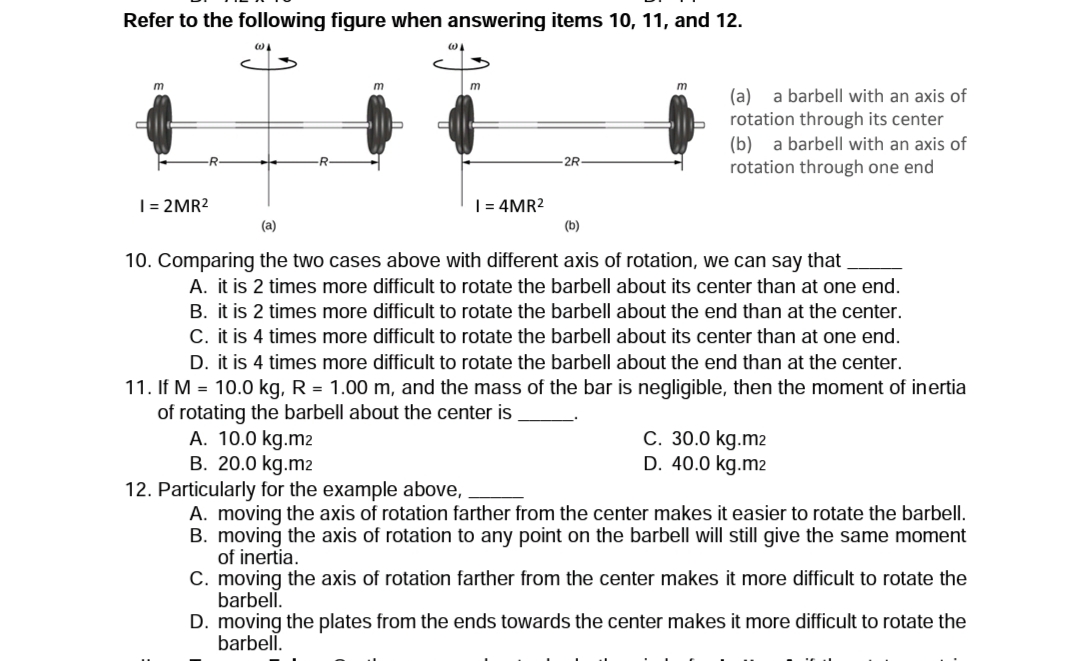m (a) a barbell with an axis of rotation through its center (b) a barbell with an axis of rotation through one end 2R |= 2MR2 | = 4MR2 (a) (b) 10. Comparing the two cases above with different axis of rotation, we can say that A. it is 2 times more difficult to rotate the barbell about its center than at one end. B. it is 2 times more difficult to rotate the barbell about the end than at the center. C. it is 4 times more difficult to rotate the barbell about its center than at one end. D. it is 4 times more difficult to rotate the barbell about the end than at the center. 11. If M = 10.0 kg, R = 1.00 m, and the mass of the bar is negligible, then the moment of inertia of rotating the barbell about the center is A. 10.0 kg.m2 B. 20.0 kg.m2 12. Particularly for the example above, %3D C. 30.0 kg.m2 D. 40.0 kg.m2 A. moving the axis of rotation farther from the center makes it easier to rotate the barbell. B. moving the axis of rotation to any point on the barbell will still give the same moment of inertia. C. moving the axis of rotation farther from the center makes it more difficult to rotate the barbell. D. moving the plates from the ends towards the center makes it more difficult to rotate the barbell.
m (a) a barbell with an axis of rotation through its center (b) a barbell with an axis of rotation through one end 2R |= 2MR2 | = 4MR2 (a) (b) 10. Comparing the two cases above with different axis of rotation, we can say that A. it is 2 times more difficult to rotate the barbell about its center than at one end. B. it is 2 times more difficult to rotate the barbell about the end than at the center. C. it is 4 times more difficult to rotate the barbell about its center than at one end. D. it is 4 times more difficult to rotate the barbell about the end than at the center. 11. If M = 10.0 kg, R = 1.00 m, and the mass of the bar is negligible, then the moment of inertia of rotating the barbell about the center is A. 10.0 kg.m2 B. 20.0 kg.m2 12. Particularly for the example above, %3D C. 30.0 kg.m2 D. 40.0 kg.m2 A. moving the axis of rotation farther from the center makes it easier to rotate the barbell. B. moving the axis of rotation to any point on the barbell will still give the same moment of inertia. C. moving the axis of rotation farther from the center makes it more difficult to rotate the barbell. D. moving the plates from the ends towards the center makes it more difficult to rotate the barbell.
Physics for Scientists and Engineers: Foundations and Connections
1st Edition
ISBN:9781133939146
Author:Katz, Debora M.
Publisher:Katz, Debora M.
Chapter13: Rotation Ii: A Conservation Approach
Section: Chapter Questions
Problem 24PQ
Related questions
Question
Please answer 10,11,12 please

Transcribed Image Text:Refer to the following figure when answering items 10, 11, and 12.
m
m
(a)
rotation through its center
(b) a barbell with an axis of
rotation through one end
a barbell with an axis of
-2R-
| = 2MR2
| = 4MR2
(a)
(b)
10. Comparing the two cases above with different axis of rotation, we can say that
A. it is 2 times more difficult to rotate the barbell about its center than at one end.
B. it is 2 times more difficult to rotate the barbell about the end than at the center.
C. it is 4 times more difficult to rotate the barbell about its center than at one end.
D. it is 4 times more difficult to rotate the barbell about the end than at the center.
11. If M = 10.0 kg, R = 1.00 m, and the mass of the bar is negligible, then the moment of inertia
of rotating the barbell about the center is
A. 10.0 kg.m2
B. 20.0 kg.m2
C. 30.0 kg.m2
D. 40.0 kg.m2
12. Particularly for the example above,
A. moving the axis of rotation farther from the center makes it easier to rotate the barbell.
B. moving the axis of rotation to any point on the barbell will still give the same moment
of inertia.
C. moving the axis of rotation farther from the center makes it more difficult to rotate the
barbell.
D. moving the plates from the ends towards the center makes it more difficult to rotate the
barbell.
Expert Solution
This question has been solved!
Explore an expertly crafted, step-by-step solution for a thorough understanding of key concepts.
This is a popular solution!
Trending now
This is a popular solution!
Step by step
Solved in 2 steps

Recommended textbooks for you

Physics for Scientists and Engineers: Foundations…
Physics
ISBN:
9781133939146
Author:
Katz, Debora M.
Publisher:
Cengage Learning

Physics for Scientists and Engineers with Modern …
Physics
ISBN:
9781337553292
Author:
Raymond A. Serway, John W. Jewett
Publisher:
Cengage Learning

Principles of Physics: A Calculus-Based Text
Physics
ISBN:
9781133104261
Author:
Raymond A. Serway, John W. Jewett
Publisher:
Cengage Learning

Physics for Scientists and Engineers: Foundations…
Physics
ISBN:
9781133939146
Author:
Katz, Debora M.
Publisher:
Cengage Learning

Physics for Scientists and Engineers with Modern …
Physics
ISBN:
9781337553292
Author:
Raymond A. Serway, John W. Jewett
Publisher:
Cengage Learning

Principles of Physics: A Calculus-Based Text
Physics
ISBN:
9781133104261
Author:
Raymond A. Serway, John W. Jewett
Publisher:
Cengage Learning

Glencoe Physics: Principles and Problems, Student…
Physics
ISBN:
9780078807213
Author:
Paul W. Zitzewitz
Publisher:
Glencoe/McGraw-Hill

Physics for Scientists and Engineers
Physics
ISBN:
9781337553278
Author:
Raymond A. Serway, John W. Jewett
Publisher:
Cengage Learning

University Physics Volume 1
Physics
ISBN:
9781938168277
Author:
William Moebs, Samuel J. Ling, Jeff Sanny
Publisher:
OpenStax - Rice University